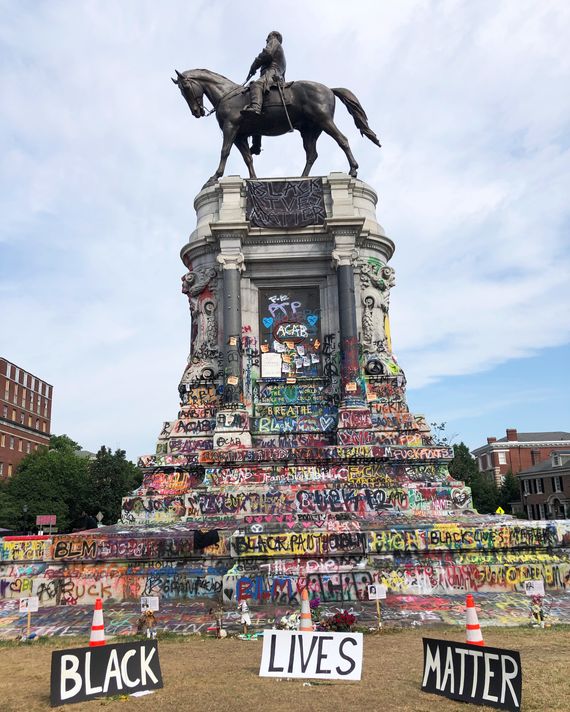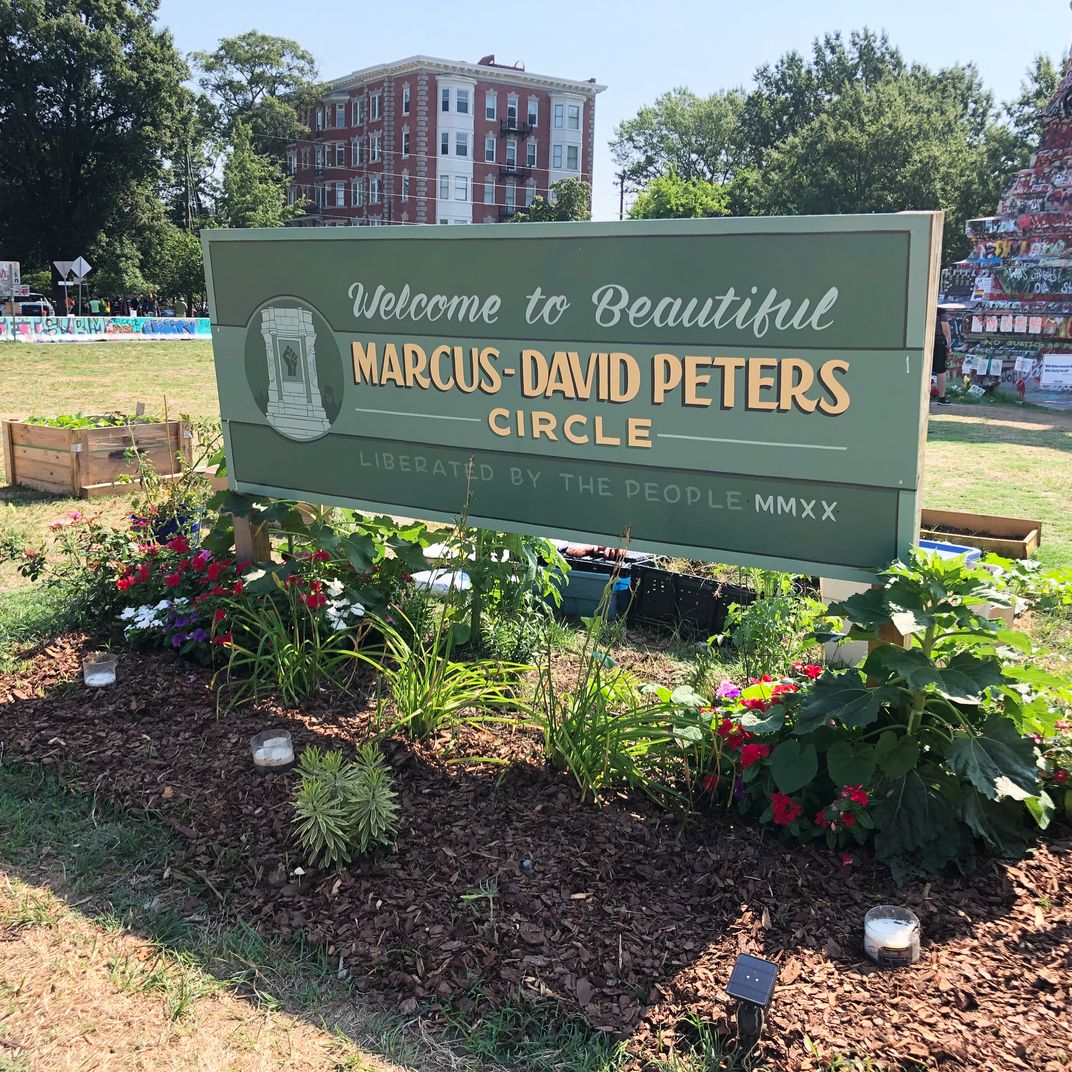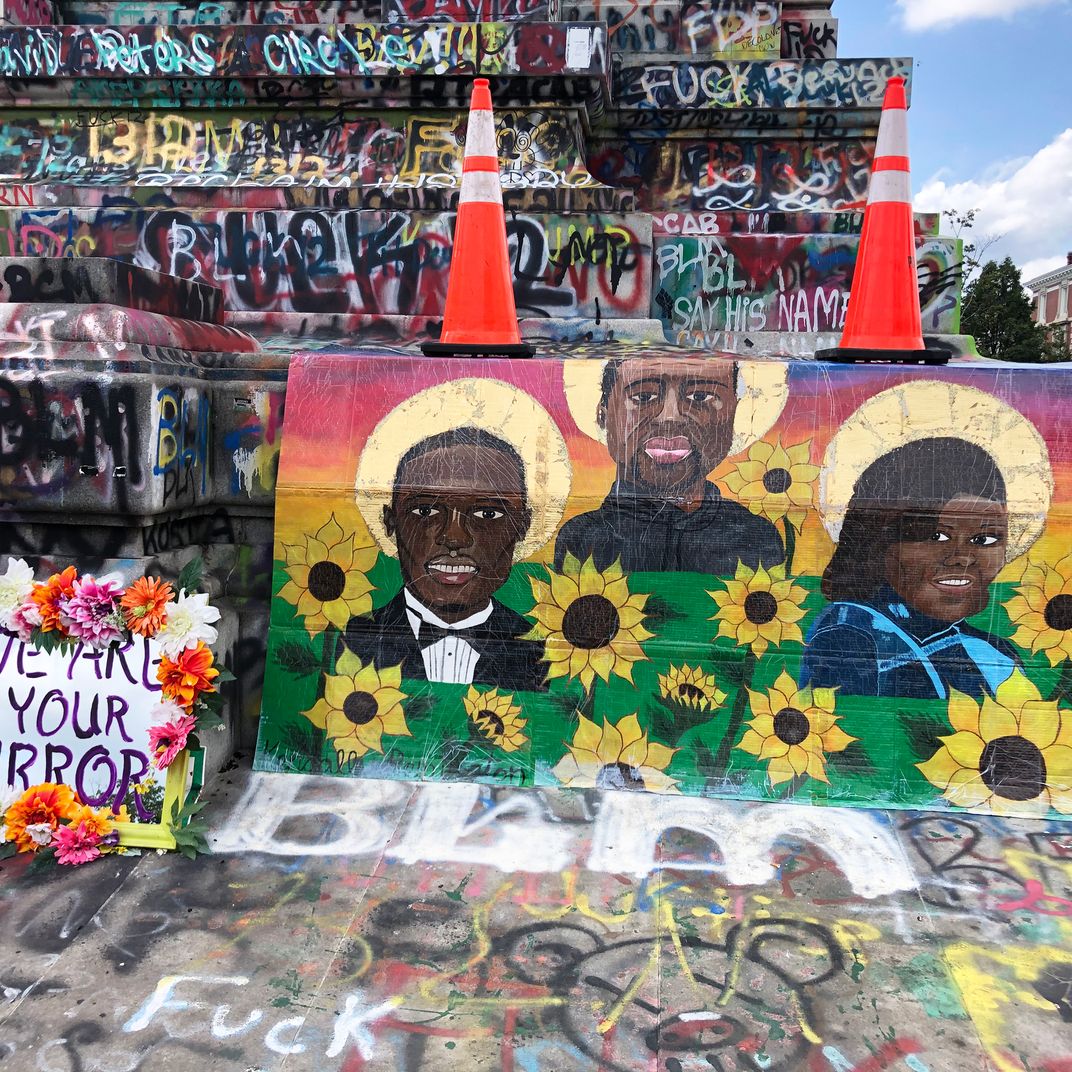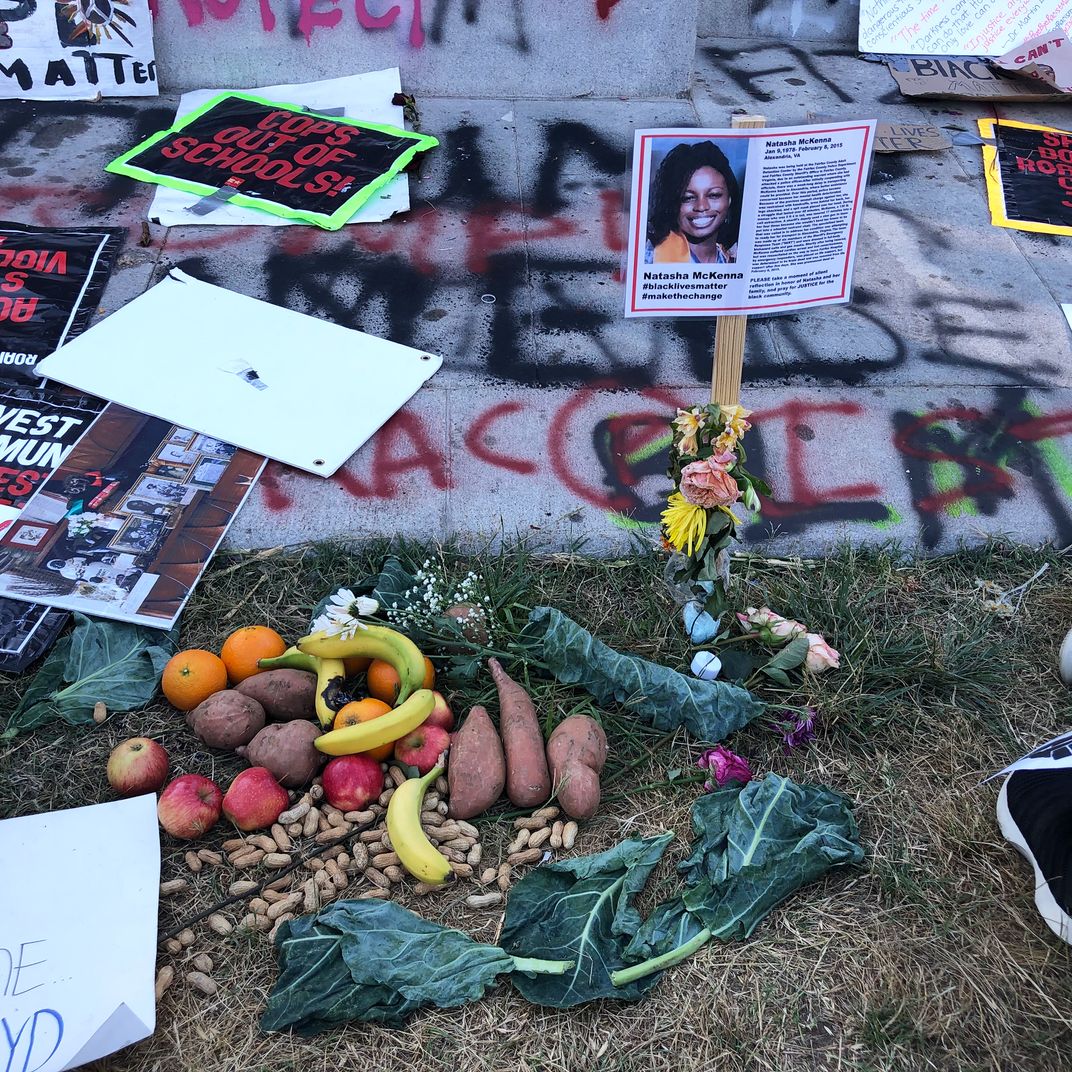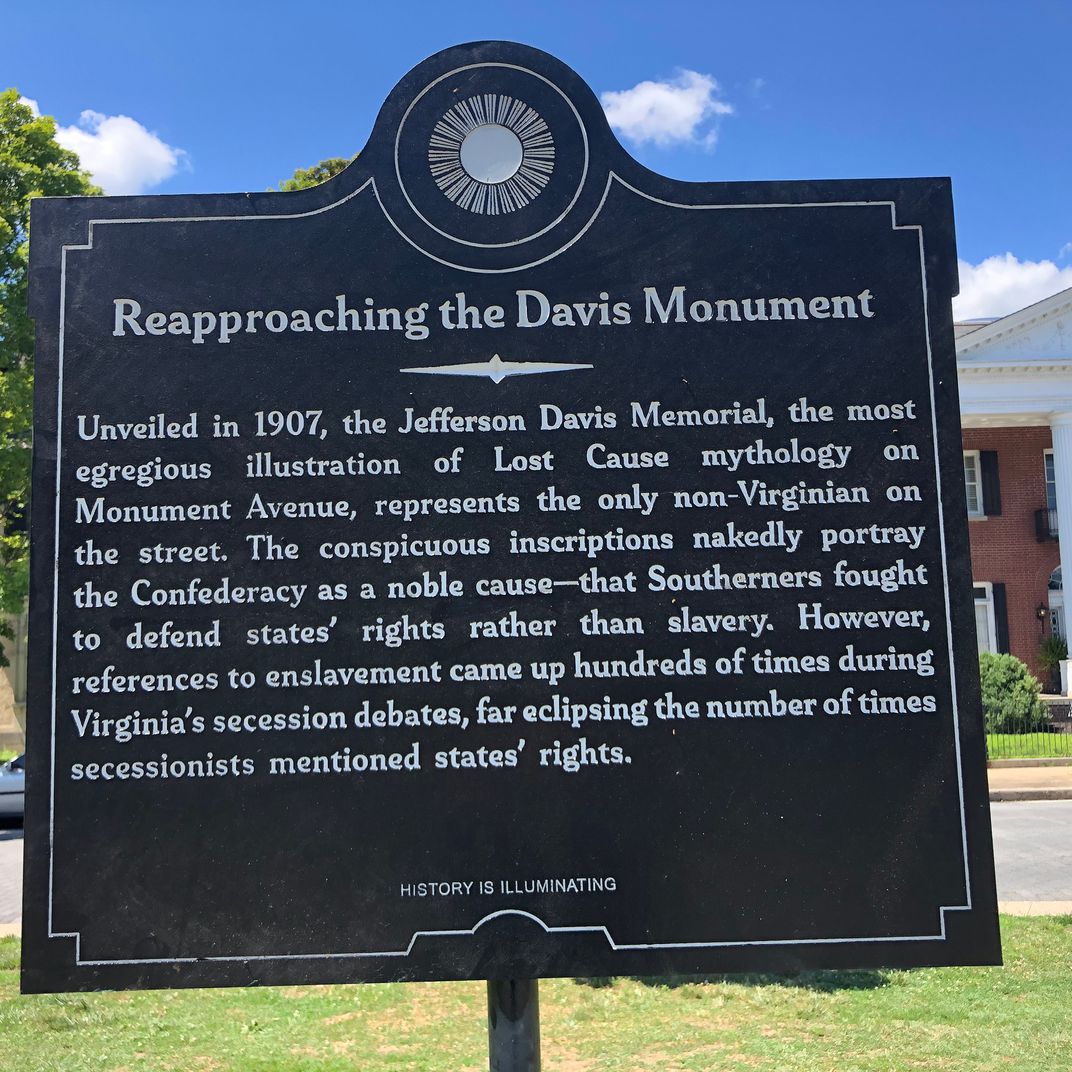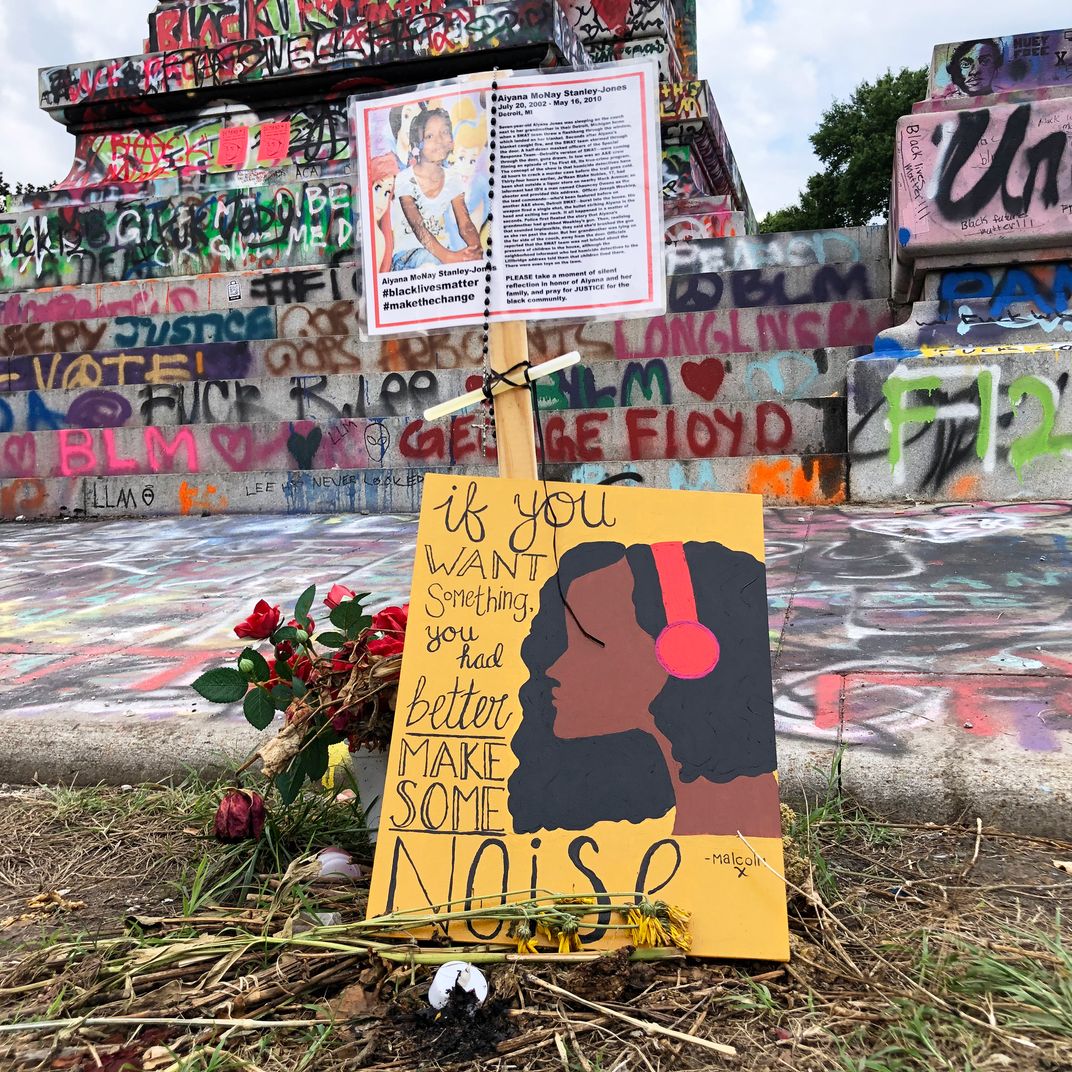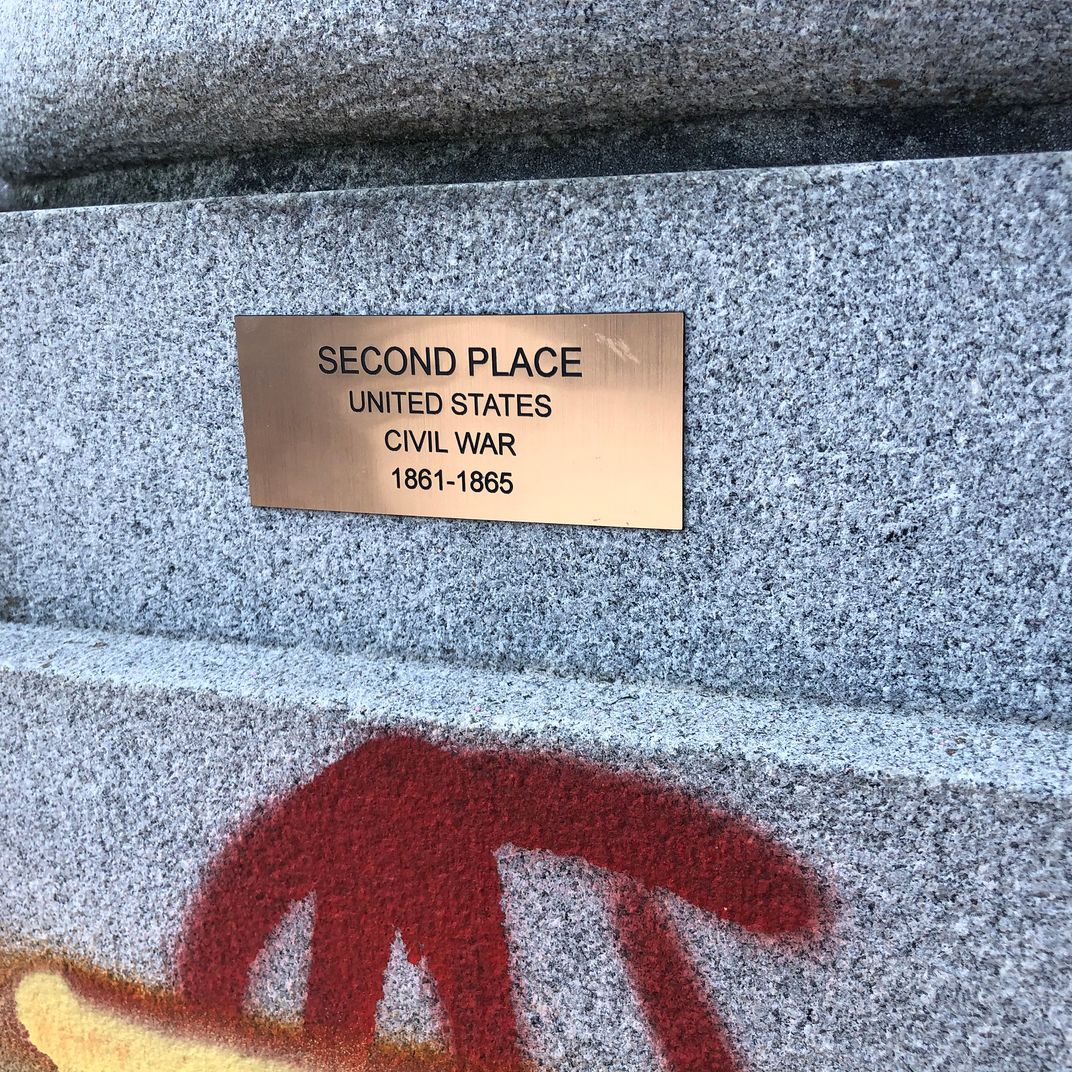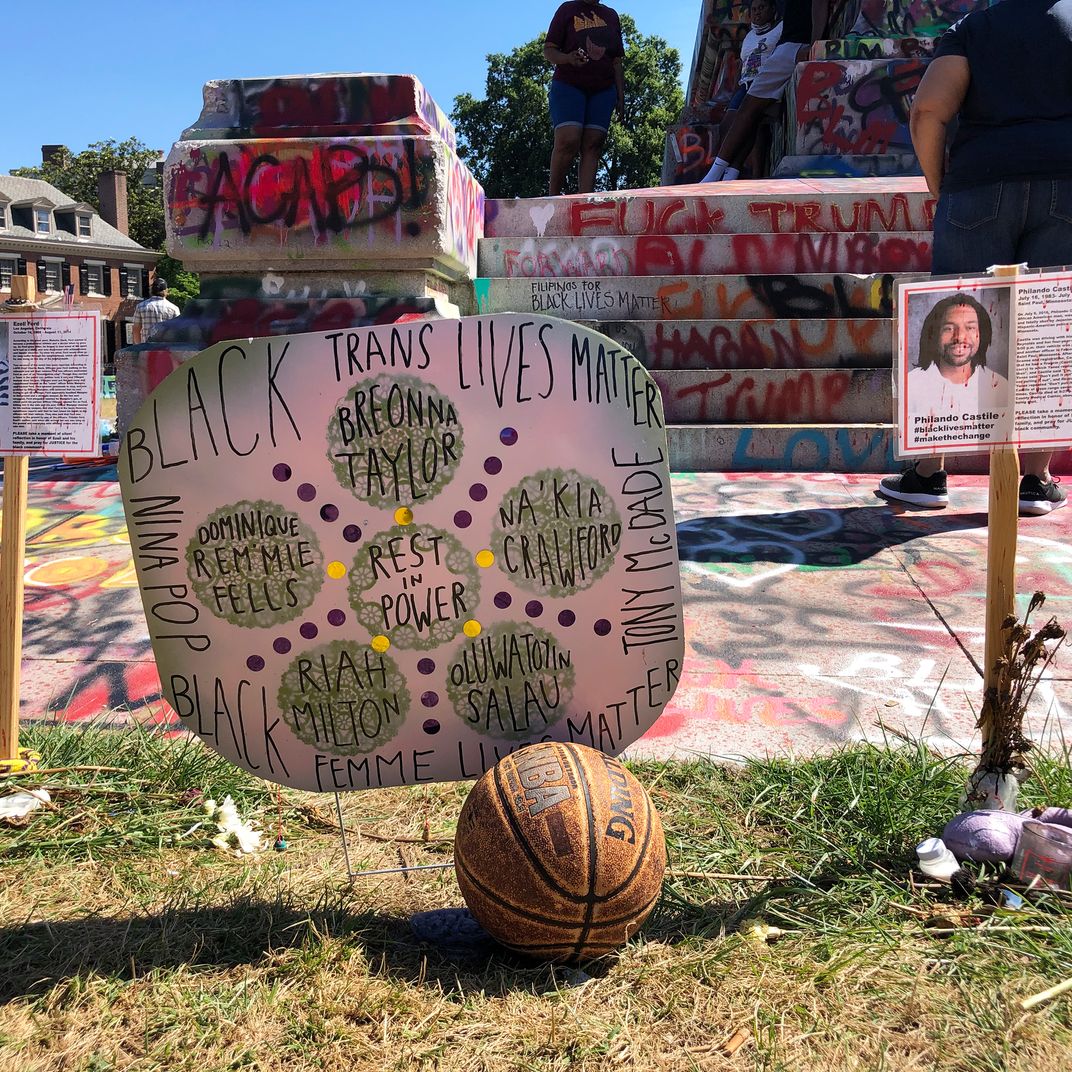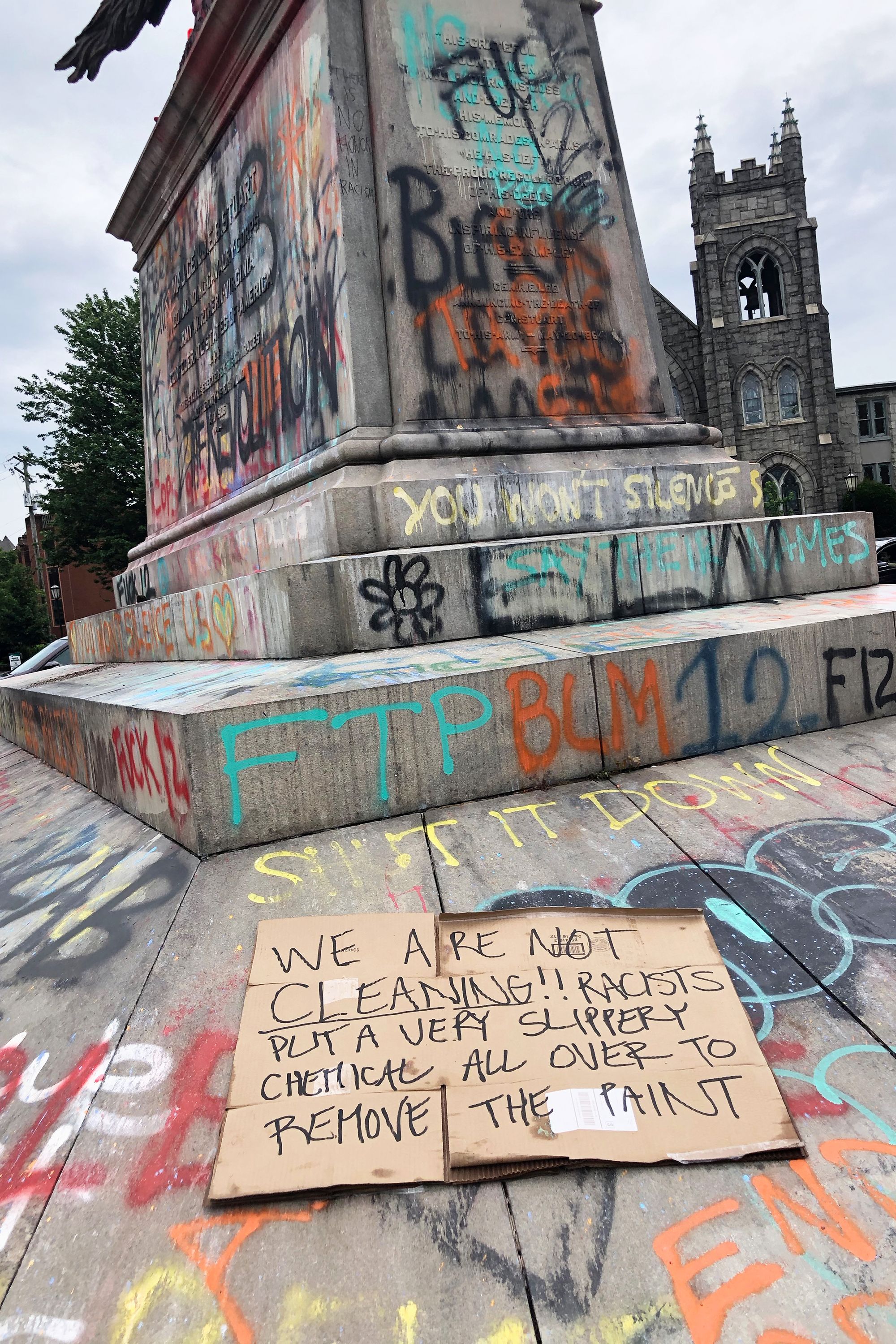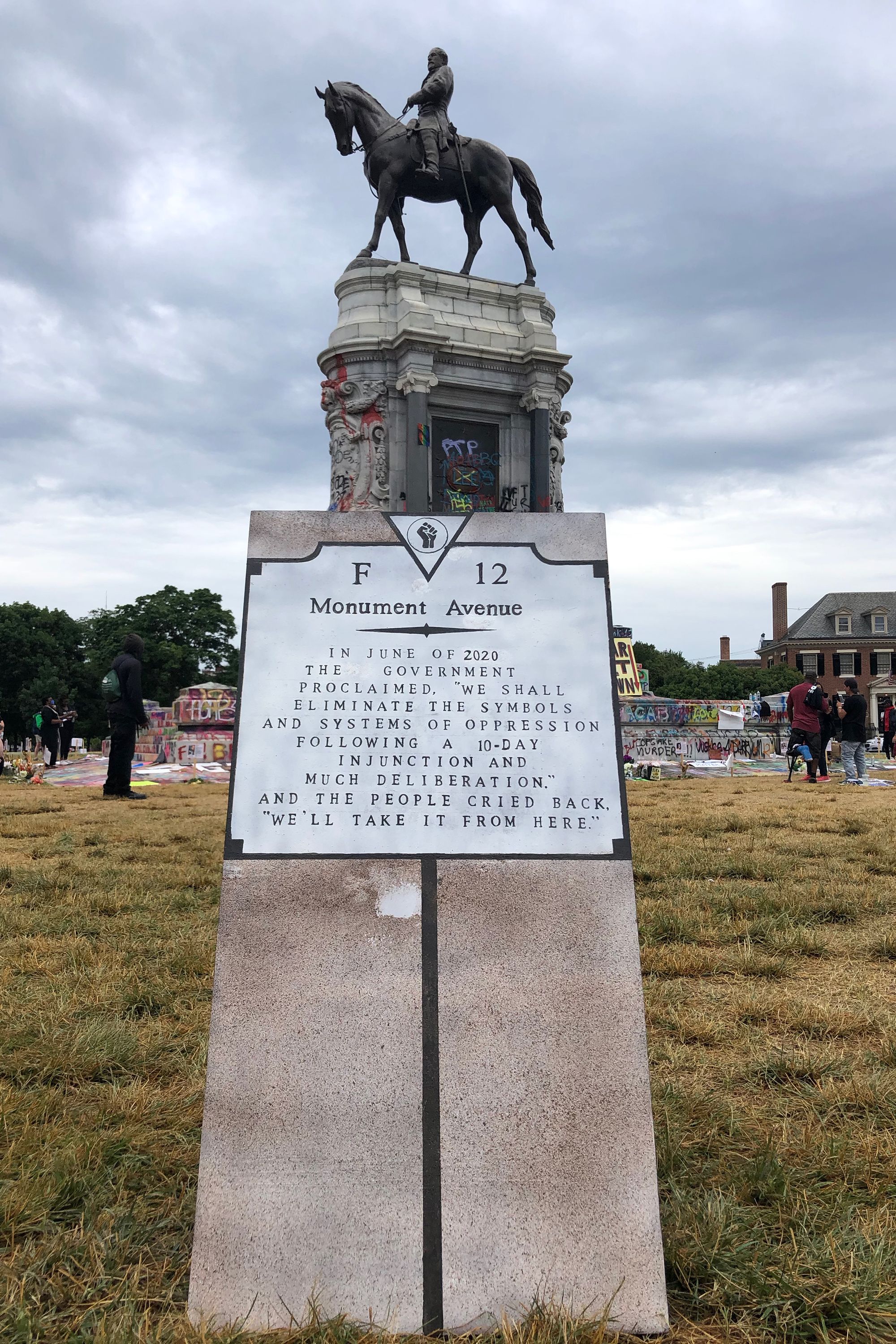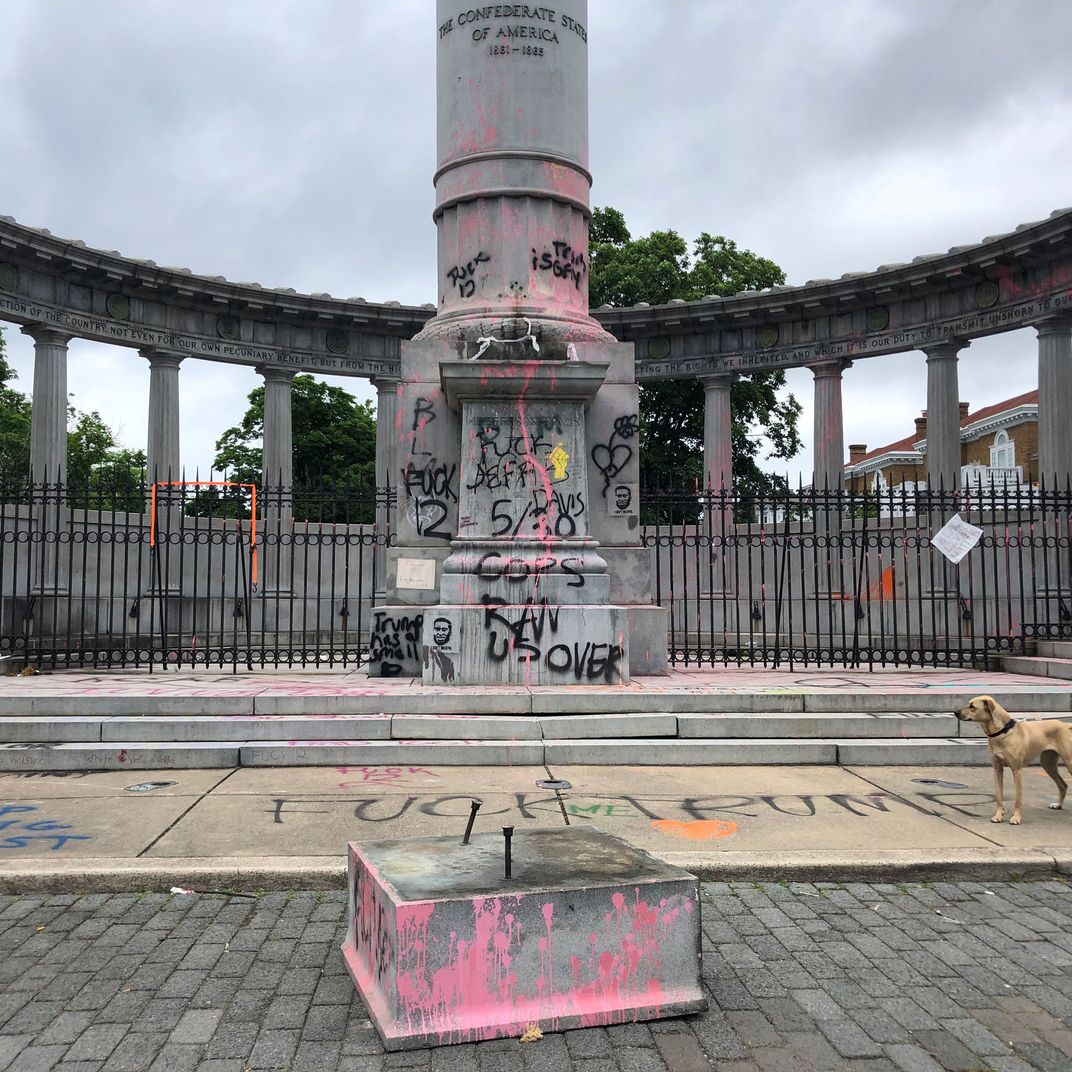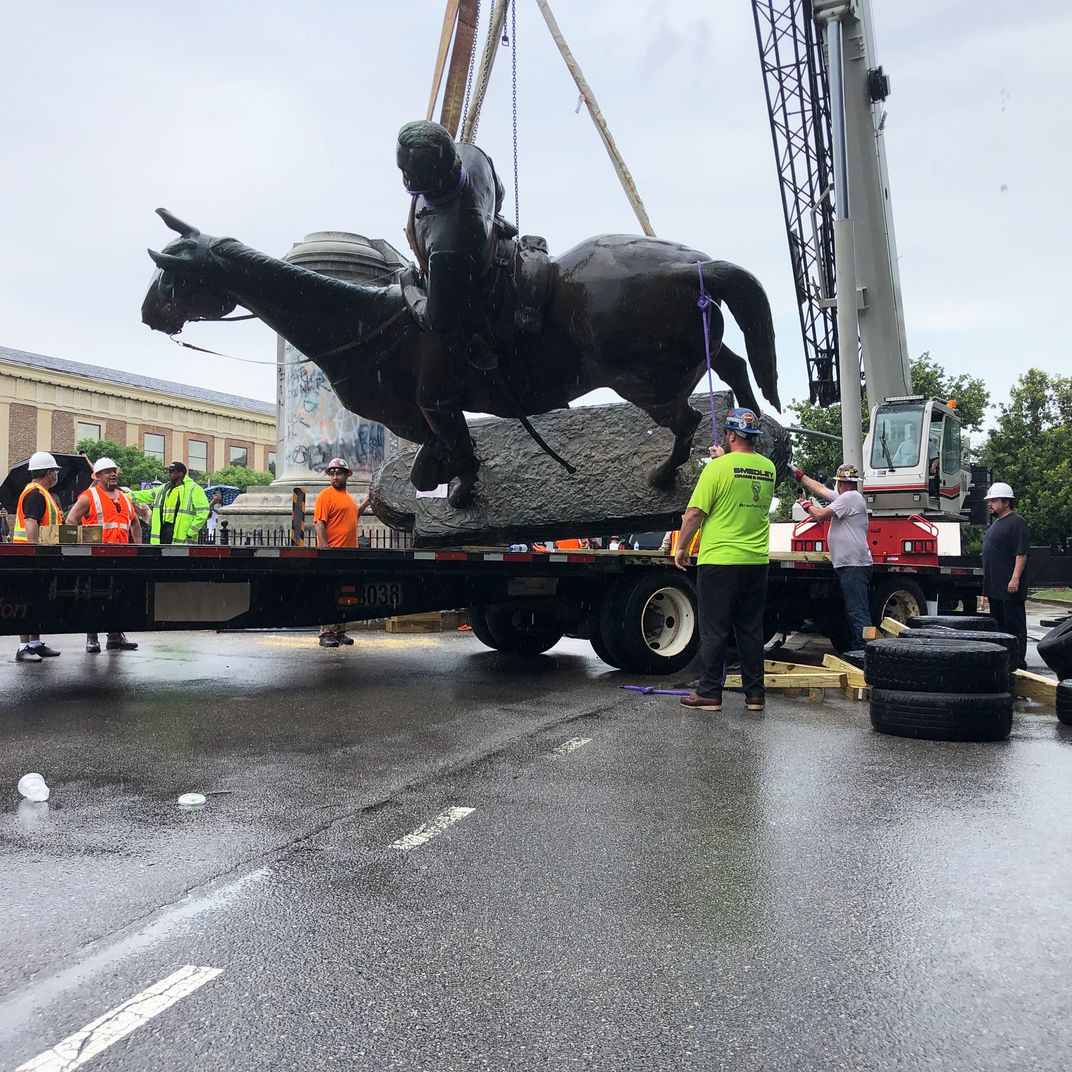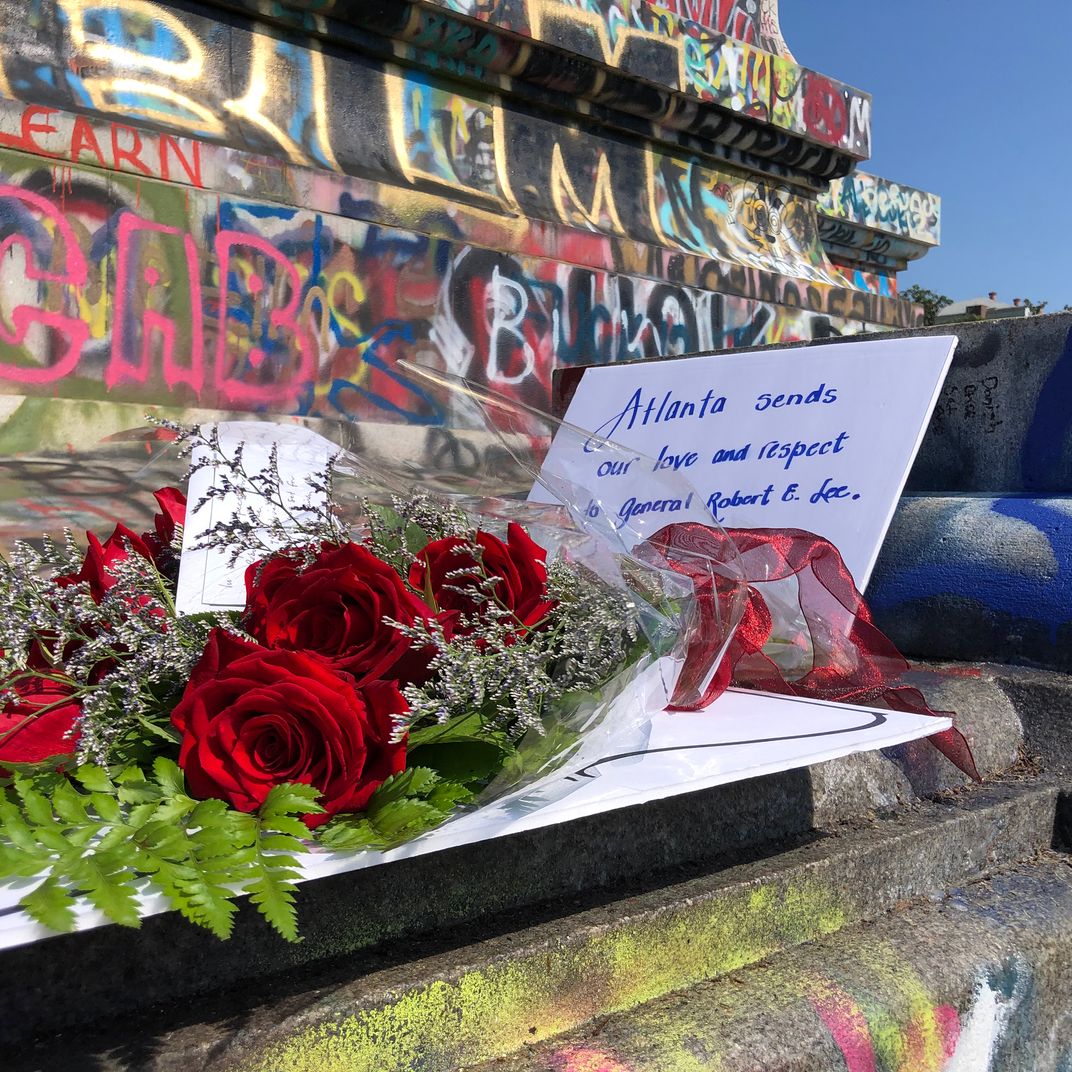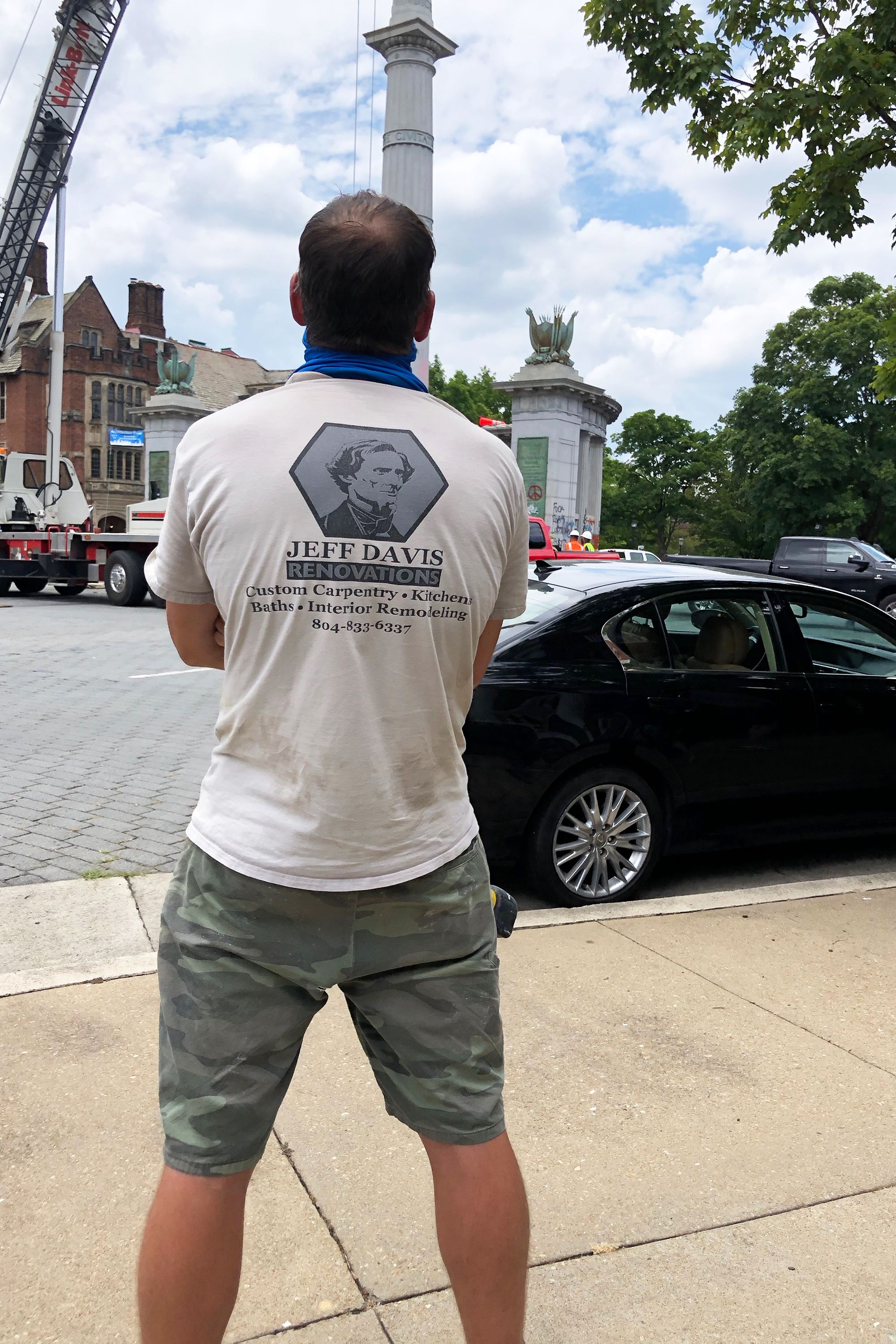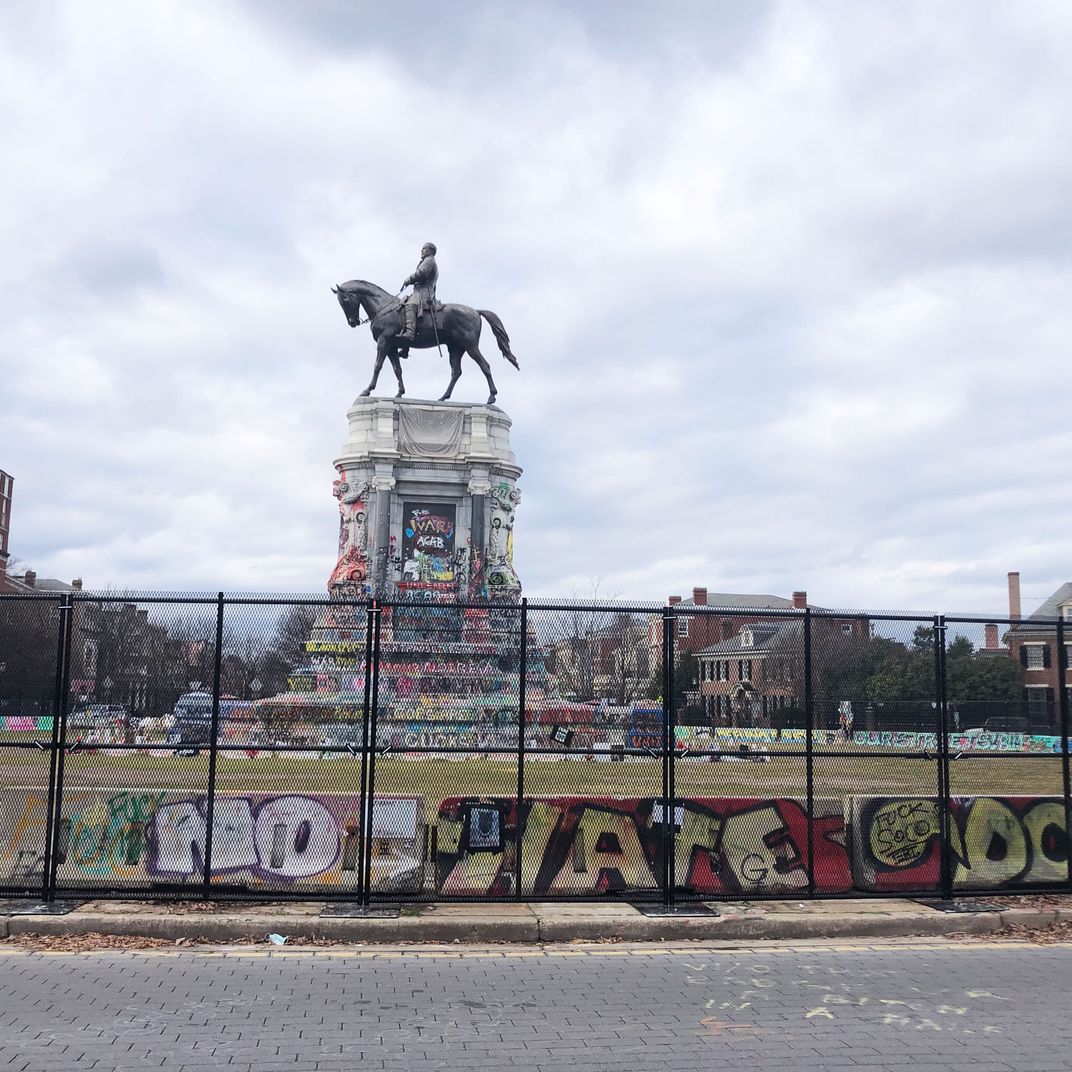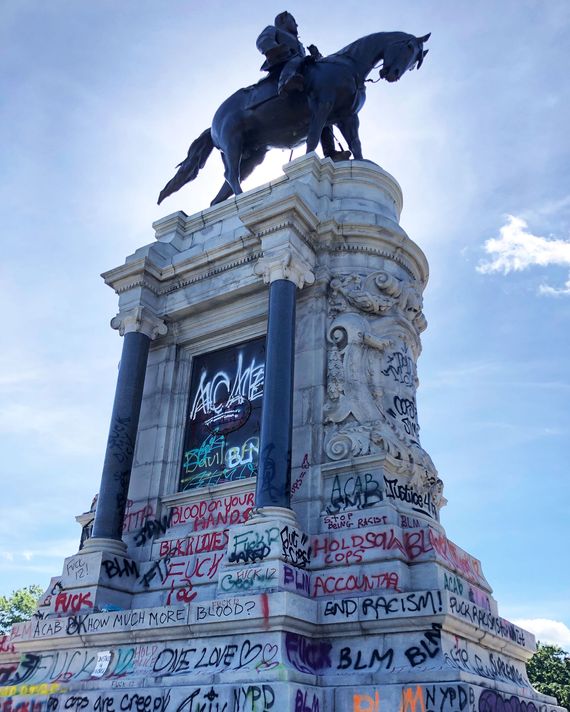
I had never lived south of Brooklyn, New York, in the United States until about seven years ago, when I moved with my child to Richmond, Virginia. One of the more jarring aspects of the city — the former capital of the Confederacy — is Monument Avenue, the “cobbled” asphalt, four-lane boulevard stretching for about a mile and a half along a wide, grassy, tree-lined median. Every few blocks, cars circle roundabouts where bronze statues on granite or marble plinths pay tribute to those who fought for the Confederacy: J.E.B. Stuart, Jefferson Davis, Stonewall Jackson, Matthew Fontaine Maury, and of course, Robert E. Lee, whose 61-foot-tall, 12-ton likeness looms over the city. During the warm months, young people — most of them white — hang out on the medians, drinking, sunbathing, and playing cornhole.
Civic groups installed the monuments after the end of the Civil War, from 1890 to 1929, during a period of intense anti-Black violence and the expansion of racist laws enforcing segregation. Since then, Monument Avenue, designated a National Historical Landmark, has served as a constant physical reminder of a deeply rooted commitment to honor and promote the Confederacy and its cause.
Following the murder of George Floyd on May 25, 2020, the monument to Lee became a central target of protesters demonstrating against police brutality and anti-Black racism. Over the course of almost a year, people gathered at its base to participate in events and demonstrations, marked it with graffiti and paintings, and planted offerings and signage that transformed the site. As an Asian American parent of a Blasian child (legible only as a Black boy, especially here in Richmond), I have a particular stake in these ongoing struggles. For nearly a year, I photographed the events unfolding at the Lee statue with my child alongside me. He was 10 when the protests in May 2020 began, and we participated in many of them. We witnessed the transformation of what was once a rarely used grassy area around the Lee statue into a space where people demonstrated, distributed food and drinks, planted tents and gardens, played basketball, performed music, and built a library of free books. Artists screen-printed T-shirts and banners on the site and projected images of George Floyd (and many others killed by police violence) over the statue of Lee. From all over the city and surrounding counties, people gathered to reclaim the monument and revise what it signifies.
The national press quickly took notice. In October 2020, The New York Times Magazine named the Lee statue “in its current state” the most influential work of American protest art since World War II. In January 2021, National Geographic featured a similar photograph of the statue on the cover of its “Year in Pictures” issue — though it carefully explained that it “de-emphasized 10 instances of the f-word that were visible.”
Less visible in the aerial and long shots of the monument were the paintings, photographs, and signs posted around it remembering those murdered by police. These ephemeral markers contrast with the bronze, marble, and granite of the Lee monument. Perhaps their transience is integral to their power. The memorials to Black lives clustered around the monument offer fleeting, fugitive counterhistories that challenge the Confederate symbols and their formal conventions. Today, the majority of the Confederate statues have been taken down after protesters removed several in June and the city announced on July 1, 2020, that it would remove the rest. Richmond has recently proposed to replace the remaining plinths with asphalt, grass, or plants. Located on state-owned land, the statue of Lee has not yet been taken down.
The images here are a selection from hundreds that I took over the course of the eventful year as we marched in demonstrations across the city and as we walked and biked up and down Monument Avenue — our daily exercise during the pandemic. As someone who teaches literary and visual texts, I am particularly interested in symbols and signs and their material effects, in the histories preserved and commemorated in monuments, and in the attempts to intervene in how history is remembered and conveyed. At the same time, I am well aware that the struggle over statues does not stand in for ongoing social struggles and that the removal of some of the monuments does not mean that long overdue actual structural and systematic transformations have taken place. The images for me, as both an insider and an outsider to Richmond, serve as a record of individual and collective attempts to link white-supremacist legacies to ongoing racism and to affirm the potential for alternative futures.
A planting and a sign renames the Robert E. Lee monument for Marcus-David Peters, a local teacher and graduate of nearby Virginia Commonwealth University, who was tasered, shot, and killed by police in Richmond in May 2018 during a mental-health crisis. This sign was removed, presumably by counterprotesters, and another one honoring Peters was installed.
A painting of Marcus-David Peters, George Floyd, and Breonna Taylor.
A memorial and offerings to Natasha McKenna, who suffered cardiac arrest after being tasered four times while being transported from the Fairfax County Adult Detention Center to receive care for mental-health issues. Although resuscitated on the way to the hospital, she was “determined to be brain dead and removed from life support after five days. She was pronounced dead on February 8, 2015.”
This cardboard sign depicts Gabriel Prosser casually sitting on the base of his own memorial, facing the Lee statue. The text on the other side of the sign commemorates Prosser (1776–1800) for having “planned [a] slave revolt in Richmond on August 30, 1800,” for which he was “captured and executed by state militia.” He had “advocated for the formation of a black independent state in central Virginia.” The sign links state militias used to control enslaved Black people to the police and contemporary anti-racist struggles to prior insurrections.
History Is Illuminating, an anonymous group of activists, artists, and historians, planted wooden signs that mimic the style of those posted around the city at sites deemed historically important. This one at the Jefferson Davis monument identified Davis as the only non-Virginian commemorated on the avenue and underscored that the Confederacy existed mainly to maintain slavery and not to defend states’ rights. Counterprotesters quickly defaced and removed the signs.
A memorial to 7-year-old Aiyana MoNay Stanley-Jones (July 20, 2002–May 16, 2010). The sign explains that the 7-year-old was asleep on a couch next to her grandmother in their home in Detroit when a SWAT team, accompanied by an A&E crew filming an episode of a true-crime program, burst through the door. The lead “commando” fired a shot that struck Aiyana in the head.
Some of the graffiti spray-painted on the monuments, like “Rob[ert E. Lee], fuck your loosing [sic] ass,” or “You lost,” mock the monuments’ attempts to glorify a mythic heroic southern history. In this vein, this small plaque affixed to the Jefferson Davis Monument awards the Confederacy second place in the Civil War.
Between markers for two Black men murdered by police, Ezell Ford and Philando Castile, a sign links the murder of Breonna Taylor to that of several other Black femmes and Black trans people, Dominique Rem’mie Fells, Na’Kia Crawford, Riah Milton, and Oluwatoyin Salau.
Many residents opposed the reclamation and removal of the statues. Some sought to restore the monuments, cleaning, painting over, and pouring corrosive chemicals to dissolve the graffiti. This placard at the monument to J.E.B. Stuart warns people that graffiti have been removed with a slippery solvent.
On June 4, 2020, Virginia governor Ralph Northam announced that the Lee statue would be removed. Four days later, after a lawsuit was filed to keep the statue in place, a judge issued a ten-day injunction that prevented its removal. This painting of a sign posted in response to the injunction resists the delays with “the people” continuing forward.
On June 10, 2020, demonstrators pulled the statue of Jefferson Davis on Monument Avenue off its pedestal.
In February 2020, Virginia state legislation gave local governments authority to remove or relocate Confederate monuments, effective July 1, 2020, and repealed the law that had previously forbidden them to do so. On July 1, 2020, citing concerns about public safety, the Richmond mayor and city council ordered the removal of a number of cannons as well as the remaining statues of the former Confederates on city-owned land, including on Monument Avenue.
After more than 100 years, the Stonewall Jackson statue is removed from Monument Avenue by the city of Richmond on July 1, 2020.
Others left their own defiant tributes to Lee, including this bouquet and note: “Atlanta sends our love and respect to General Robert E. Lee,” which was left on August 11, 2020, the third anniversary of the violent white-supremacist “Unite the Right” rally in Charlottesville.
Someone wearing a shirt for a local contracting company named after Jefferson Davis, the former president of the Confederate States, watches the removal of the “Vindacatrix” statue, derived from the Confederate motto, Deo Vindice (“With God As Our Protector”), on top of the Jefferson Davis Memorial, July 8, 2020.
On January 25, 2021, a spokesperson announced that the state had erected a fence around the Lee statue “to ensure the safety of visitors and workers as part of [the state’s] plan to prepare the site for the removal of the Lee statue” and emphasized that the fence was not permanent. The statue remains along with the fencing. Signs on the fence read: “The Department of General Services will dispose of any items affixed to or left at the fence.” But spray-painted on the sidewalk in front is a message: “Understand: We are never leaving.”
A planting and a sign renames the Robert E. Lee monument for Marcus-David Peters, a local teacher and graduate of nearby Virginia Commonwealth University, who was tasered, shot, and killed by police in Richmond in May 2018 during a mental-health crisis. This sign was removed, presumably by counterprotesters, and another one honoring Peters was installed.
A painting of Marcus-David Peters, George Floyd, and Breonna Taylor.
A memorial and offerings to Natasha McKenna, who suffered cardiac arrest after being tasered four times while being transported from the Fairfax County Adult Detention Center to receive care for mental-health issues. Although resuscitated on the way to the hospital, she was “determined to be brain dead and removed from life support after five days. She was pronounced dead on February 8, 2015.”
This cardboard sign depicts Gabriel Prosser casually sitting on the base of his own memorial, facing the Lee statue. The text on the other side of the sign commemorates Prosser (1776–1800) for having “planned [a] slave revolt in Richmond on August 30, 1800,” for which he was “captured and executed by state militia.” He had “advocated for the formation of a black independent state in central Virginia.” The sign links state militias used to control enslaved Black people to the police and contemporary anti-racist struggles to prior insurrections.
History Is Illuminating, an anonymous group of activists, artists, and historians, planted wooden signs that mimic the style of those posted around the city at sites deemed historically important. This one at the Jefferson Davis monument identified Davis as the only non-Virginian commemorated on the avenue and underscored that the Confederacy existed mainly to maintain slavery and not to defend states’ rights. Counterprotesters quickly defaced and removed the signs.
A memorial to 7-year-old Aiyana MoNay Stanley-Jones (July 20, 2002–May 16, 2010). The sign explains that the 7-year-old was asleep on a couch next to her grandmother in their home in Detroit when a SWAT team, accompanied by an A&E crew filming an episode of a true-crime program, burst through the door. The lead “commando” fired a shot that struck Aiyana in the head.
Some of the graffiti spray-painted on the monuments, like “Rob[ert E. Lee], fuck your loosing [sic] ass,” or “You lost,” mock the monuments’ attempts to glorify a mythic heroic southern history. In this vein, this small plaque affixed to the Jefferson Davis Monument awards the Confederacy second place in the Civil War.
Between markers for two Black men murdered by police, Ezell Ford and Philando Castile, a sign links the murder of Breonna Taylor to that of several other Black femmes and Black trans people, Dominique Rem’mie Fells, Na’Kia Crawford, Riah Milton, and Oluwatoyin Salau.
Many residents opposed the reclamation and removal of the statues. Some sought to restore the monuments, cleaning, painting over, and pouring corrosive chemicals to dissolve the graffiti. This placard at the monument to J.E.B. Stuart warns people that graffiti have been removed with a slippery solvent.
On June 4, 2020, Virginia governor Ralph Northam announced that the Lee statue would be removed. Four days later, after a lawsuit was filed to keep the statue in place, a judge issued a ten-day injunction that prevented its removal. This painting of a sign posted in response to the injunction resists the delays with “the people” continuing forward.
On June 10, 2020, demonstrators pulled the statue of Jefferson Davis on Monument Avenue off its pedestal.
In February 2020, Virginia state legislation gave local governments authority to remove or relocate Confederate monuments, effective July 1, 2020, and repealed the law that had previously forbidden them to do so. On July 1, 2020, citing concerns about public safety, the Richmond mayor and city council ordered the removal of a number of cannons as well as the remaining statues of the former Confederates on city-owned land, including on Monument Avenue.
After more than 100 years, the Stonewall Jackson statue is removed from Monument Avenue by the city of Richmond on July 1, 2020.
Others left their own defiant tributes to Lee, including this bouquet and note: “Atlanta sends our love and respect to General Robert E. Lee,” which was left on August 11, 2020, the third anniversary of the violent white-supremacist “Unite the Right” rally in Charlottesville.
Someone wearing a shirt for a local contracting company named after Jefferson Davis, the former president of the Confederate States, watches the removal of the “Vindacatrix” statue, derived from the Confederate motto, Deo Vindice (“With God As Our Protector”), on top of the Jefferson Davis Memorial, July 8, 2020.
On January 25, 2021, a spokesperson announced that the state had erected a fence around the Lee statue “to ensure the safety of visitors and workers as part of [the state’s] plan to prepare the site for the removal of the Lee statue” and emphasized that the fence was not permanent. The statue remains along with the fencing. Signs on the fence read: “The Department of General Services will dispose of any items affixed to or left at the fence.” But spray-painted on the sidewalk in front is a message: “Understand: We are never leaving.”


